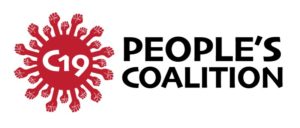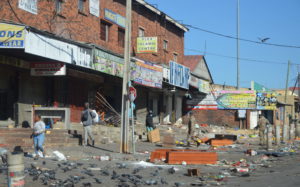by Dinga Sikwebu
Going through the more than 800-pages of the report of the judicial commission of inquiry into state capture, makes one’s blood freeze. To discover that parallel to the unending public discussions to build a ‘developmental or capable state’, former president Jacob Zuma and his coterie were hatching in the still of the night plans with a consulting company Bain to set up a ‘delivery agency’ outside of government to restructure the economy and other organs of state, shows the duplicity of the ‘state capture’ exercise. If implemented, the anti-democratic initiative would have removed governance oversight and centralised government procurement for thieving. With powers to “approve projects and supervise budgets”, the agency would be answerable directly to the president. It was to have a mandate to even take over work within ministries under the pretext of “clearing execution roadblocks”.
The calculated and brazen manner in which the hijackers implemented their plans to seize and repurpose government entities and processes, shows that what happened was an attempt at a ‘silent coup’. Like stock thieves, those involved coordinated their depraved plans. They were also ruthless and heartless in their execution.
But a big question that kept cropping up when one read the report – where were trade unions when the capturers raided the kraal? Restructuring of companies, purging of employees and bullying in the workplace are bread and butter issues for labour movements. In a country where there is a strong union presence in state-owned companies, how did all this happen without labour sounding the alarm bell? Active unionists sit on boards and other policy forums of state-owned companies. Unlike in the private sector where unionisation rates hover in the twenties, union density which is a measure of formal employees who are union members, stands at about 70 percent in the public service. With its state-centred perspective of development and a history of casting its eyes beyond the workplace, indeed the expectation was that South Africa’s labour movement would on behalf of society, pay attention to changes at the level of the state and jealously guard the country’s state-owned companies.
The investigations, including the work of the Zondo commission carried out over a decade, have bequeathed us with ample examples and references of how unions were themselves targets of capture so that labour is in a position to facilitate the raid on state resources. There is also strong evidence that within the labour movement there exists denialism and ambivalence about state capture. The ideological straightjacket that argues that “capitalism by its very nature is corrupt” has led to lip service being paid to anti-corruption campaigns and a dismissal of the struggle against state capture as a reformist endeavour.
In the Zondo commission report published in January, union dissatisfaction appears to be the motivation advanced for the purging of Mathulwane Emily Mpshe who acted as South African Airways’ chief executive between July and November 2015. A further reference to unions is in the section that deals with the removal of Barbara Hogan as the minister of public enterprises. The report cites Hogan’s evidence which listed the transport union Satawu as one of the organisations that released statements that cast her and the Transnet board as “anti-transformation and racist”.
Secondly, and without anticipating how Judge Zondo will deal with evidence of Angelo Agrizzi in subsequent reports, it appears that the company Bosasa understood the crucial role that unions can play in self-reinforcing corruption networks that integrate a number of players. In his evidence, Agrizzi testified how early on in the company’s existence, to win catering contracts in mines, Bosasa preferred the involvement of unions in the selection and appointment of providers. To ensure that the company received tenders, it gave backhanders to local union leaders such as contributions to family funerals, paying for car hire and hard cash. In return, the local leaders and shopstewards were expected to do everything in their power, including taking workers out on a strike, to ensure that Bosasa received the tenders.
In addition to these practices in the mining sector, under oath Agrizzi referred to a meeting that he and Bosasa’s chief executive Gavin Watson held with the general secretary of the chemical union Simon Mofokeng. In the meeting, the union leader provided confidential pricing information for a catering tender at Sasol. After Bosasa won the contract from 1999 to 2002, according to Agrizzi’s testimony, Mofokeng received regular bribes, monthly payments, and Bosasa employed his wife. Agrizzi also mentioned a meeting that involved the general secretary of the prison warders’ union to discuss a department of correctional services’ tender.
The third example of how unions were drawn into corrupt networks, emerged in the public protector Thuli Madonsela’s report on allegations of maladministration, financial mismanagement, irregular appointment and tender irregularities levelled against the Passenger Rail Agency of South Africa (Prasa). In her report published in 2015, the public protector found Satawu’s role ‘discomforting’ and ‘inexplicable’. Having lodged 37 complaints, including victimisation of whistle-blowers by the agency’s chief executive Lucky Montana, Satawu issued an attorney’s letter declaring that it was distancing itself and withdrawing allegations that its president had filed with the public protector. The attempted withdrawal is one of the causes of a fracture within the organisation and the formation of a splinter union, the National Transport Movement (NTM). After Prasa’s refusal to cooperate with the public protector’s office citing Satawu’s withdrawal, the matter went forward after the NTM assumed the role of a new complainant.
The fourth example that shows union ambivalence to state capture involves the Communication Workers Union (CWU) at the South African Broadcasting Corporation (SABC). In March 2014, the union’s KZN provincial secretary launched a scathing attack on Madonsela, labelling her the “mouthpiece of the opposition Democratic Alliance”. In her report, the public protector had found that “there was systemic corporate governance failure at the SABC” and that the appointment of Hlaudi Motsoeneng as the chief operations officer was irregular. Although CWU’s national office distanced itself and took action against the provincial secretary for his utterances, the union continued to voice its support for the ‘good work’ that Motsoeneng was carrying out at the broadcasting corporation. It also rejected any assertion that there was ‘state capture’ at SABC.
The union’s support for Motsoeneng was further demonstrated in the campaign for reinstatement of eight journalists who were dismissed in 2016 for coming out against an SABC ban to broadcast footage of violent protests. In a book on the reinstatement campaign, one of the dismissed journalists Foeta Krige describes how in the middle of their struggle, they were met by a group of demonstrators, including members of CWU, waving placards with slogans – ‘Hlaudi is simply the best’, ‘We stand resolute with the COO’ and ‘SABC is better than before’. According to her, the group were at the headquarters to counter a picket that supported the SABC 8.
With these examples and references to alleged practices within the labour movement, it is unfortunate that not a single union, actively gathered information amongst members and made submission to the commission. The Zondo commission regularly made calls for individuals and organisations that could assist the inquiry to come forward and give evidence. In a national congress resolution on corruption adopted in 2012, Cosatu pledged amongst many things to support the efforts of the public protector. In September 2015 and as part of a broad civil society anti-corruption coalition, the metalworkers’ union Numsa, was the first to call for a judicial inquiry into corruption.
There is no doubt that the machinations chronicled in the commission’s first report has further entrenched the inequality trap in South Africa, further disadvantaging the poor. Jobs have been lost, infrastructure ruined, institutions hollowed and more seriously trust in the political system corroded. Corruption affects economic development and limits access to social justice by vulnerable groups. To combat the socio-economic impacts of corruption and state capture requires labour as one of the players.
What comes through from the part of the commission’s report that we have, is that one of the knobkieries that grabbers used to further their aims, was workplace bullying and intimidation. To circumvent the return of state capture, we need to deal with workplace bullying. In a context where the existing legal framework does not recognise bullying as a cause of action, University of the Free State law professor Dina Maria Smit urges companies “to adopt zero tolerance policies” to deal with bullying at a workplace level. For these policies to work, will need unions and other shopfloor stakeholders.
Two of the ten recommendations in the report – the one on a national charter against corruption in public procurement and the one on strengthening of whistle-blower protection – for successful implementation, depend on embracement by unions. Judge Zondo lists trade unions as important and potential signatories of the charter. Employees are also vital in any whistleblowing process. Without the support of their unions, workers will be unable to play this role. For all of this to happen, unions need to change. Firstly, they need to see corruption as a working class issue. Secondly, they need internal measures to weed out the corruption that take place within worker organisations.
Sikwebu is a retired trade unionist based in Johannesburg.

